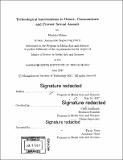| dc.contributor.advisor | Chris Schmandt. | en_US |
| dc.contributor.author | Mohan, Manisha | en_US |
| dc.contributor.other | Program in Media Arts and Sciences (Massachusetts Institute of Technology) | en_US |
| dc.date.accessioned | 2017-12-05T19:17:27Z | |
| dc.date.available | 2017-12-05T19:17:27Z | |
| dc.date.copyright | 2017 | en_US |
| dc.date.issued | 2017 | en_US |
| dc.identifier.uri | http://hdl.handle.net/1721.1/112540 | |
| dc.description | Thesis: S.M., Massachusetts Institute of Technology, School of Architecture and Planning, Program in Media Arts and Sciences, 2017. | en_US |
| dc.description | Cataloged from PDF version of thesis. | en_US |
| dc.description | Includes bibliographical references (pages 83-85). | en_US |
| dc.description.abstract | Every 98 seconds, a person in the United States is sexually abused. Every 16 hours, a woman in the United States is murdered by her romantic partner or ex-partner. Sexual abuse, assault, and harassment are regarded as some of the most common human rights violations in the world by the United Nations. Our work examines methods to prevent sexual assault, from pre-historic times to latest technologies, to inform contemporary designs. In this thesis, we investigate multiple methods to detect initial signs of assault and develop methods for communication and prevention of assault. We also explore olfactory stimuli as a potential means to prevent sexual assault in real-time. We present three technological interventions which can seamlessly integrate with existing clothing to respond to initial signs of assault like forced disrobing. The proposed solutions aim to combat Child Sexual Abuse (CSA), College Campus assault and abuse of elderly and disabled. The proposed solution operates in two modes, an active mode for instances when the victim is unconscious or cannot fight against the assaulter, for example in case infants, bed-ridden patients, elderly, disabled, intoxicated people and the passive mode where the victim can self-actuate the safety mechanism. Both modes release distress signals to prevent an assault in real-time, also alert the victim's friends and family, and call emergency services for help. Our clothing design is based on input from sexual assault survivors, 338 on-line participants, 67 volunteers and 20 users who helped us understand the real world feasibility of our system. Users evaluated the clothing appeal, functionality, cultural sensitivity and provided feedback on their general sense of security wearing the smart clothing. We demonstrate the practicality of our unobtrusive design with user studies that support our technological development and use of olfactory stimuli by showing the effect of smells on sexual arousal and partner selection. We believe our technosocial approach can help improve user safety and prevent sexual assault. | en_US |
| dc.description.statementofresponsibility | by Manisha Mohan. | en_US |
| dc.format.extent | 85 pages | en_US |
| dc.language.iso | eng | en_US |
| dc.publisher | Massachusetts Institute of Technology | en_US |
| dc.rights | MIT theses are protected by copyright. They may be viewed, downloaded, or printed from this source but further reproduction or distribution in any format is prohibited without written permission. | en_US |
| dc.rights.uri | http://dspace.mit.edu/handle/1721.1/7582 | en_US |
| dc.subject | Program in Media Arts and Sciences () | en_US |
| dc.title | Technological interventions to detect, communicate and prevent sexual assault | en_US |
| dc.type | Thesis | en_US |
| dc.description.degree | S.M. | en_US |
| dc.contributor.department | Program in Media Arts and Sciences (Massachusetts Institute of Technology) | en_US |
| dc.identifier.oclc | 1012944378 | en_US |
